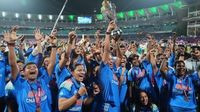The night of November 2, 2025, will forever be etched in the annals of Indian sport as the day the Indian women’s cricket team finally scaled their Everest. At the DY Patil Stadium in Navi Mumbai, Harmanpreet Kaur’s squad delivered a performance brimming with resolve, skill, and redemption, defeating South Africa by 52 runs to clinch their first-ever Women’s Cricket World Cup title. It was a night where history was rewritten, heartbreaks of the past were avenged, and the dreams of countless girls and women across India found their ultimate validation on cricket’s grandest stage.
After years of being tantalizingly close—runners-up in both the 2005 and 2017 finals—the Indian team could finally lay claim to the coveted trophy. The magnitude of this victory cannot be overstated. Not only does it place India among an elite group of Women’s World Cup champions—joining Australia, England, and New Zealand—but it also cements the legacy of a generation of players who refused to let past failures define them. "We were waiting for this moment, and now this moment has come," captain Harmanpreet Kaur reflected, her words echoing the collective sigh of relief and jubilation that swept across the nation. "Now we want to make this a habit."
The final itself was a contest worthy of the occasion. South Africa, making their first appearance in a World Cup final after a resounding 125-run win over England in the semifinals, won the toss and sent India in to bat. What followed was a display of batting prowess that set the tone for the evening. Shafali Verma, a late addition to the squad after an injury to Pratika Rawal, seized her second chance with both hands. The 21-year-old opener smashed a career-best 87 off just 78 balls, peppering the boundary with seven fours and two sixes, and anchoring a 104-run opening stand with the ever-reliable Smriti Mandhana (45).
Verma’s innings was the stuff of legend, not just for its audacity but for its timing. "God sent me to do something good, and that was reflected today," Verma said after being named player of the match. "I only focused on making runs today. My mind was clear." Her clarity and composure under pressure gave India the perfect start, and when Mandhana fell in the 18th over to Chloe Tryon, Verma partnered with Jemimah Rodrigues (24) to keep the scoreboard ticking.
India’s innings was briefly interrupted by rain, delaying the final by two hours, but the batters refused to let the momentum slip. After Verma and Rodrigues departed in quick succession, Harmanpreet Kaur and Deepti Sharma took up the mantle, adding a crucial 52-run partnership. Sharma’s contribution was especially vital—her run-a-ball 58 included three boundaries and a six, and she would later return to torment South Africa with the ball. Richa Ghosh’s late cameo and a 47-run sixth-wicket stand with Sharma helped India post a formidable 298-7 in their 50 overs, the second-highest total ever in a Women’s World Cup final.
South Africa’s chase began under immense pressure. Medium pacer Renuka Singh kept things tight, and the first breakthrough came via a sharp direct hit from Amanjot Kaur, running out Tazmin Brits (23) in the 10th over. Laura Wolvaardt, South Africa’s inspirational captain, tried to steady the ship. She reached her half-century off 45 balls and went on to compile a magnificent 101 off 98 deliveries, becoming the tournament’s leading run-scorer with 571 runs at an astonishing average of 71.37.
But India’s bowlers, led by the irrepressible Deepti Sharma, had other ideas. Sharma, who finished the tournament as the highest wicket-taker with 22 scalps, produced a spell for the ages. Her figures of 5-39 from 9.3 overs included the final wicket, sparking scenes of unbridled joy among players and fans alike. Sharma’s double strike in the middle overs—removing Wolvaardt and Chloe Tryon in quick succession—effectively ended South Africa’s hopes. "I enjoyed myself with both bat and ball," Sharma said, dedicating her performance and the trophy to her parents. "We were not relaxed at any time, but we were calm."
Shafali Verma’s gentle off-breaks also proved decisive, as she picked up two wickets for 36 runs and broke crucial partnerships just when South Africa threatened to claw back. The Proteas, despite partnerships between Wolvaardt and Sune Luus (25), and later with Sinalo Jafta (16) and Annerie Dercksen (35), could not sustain the required momentum. South Africa were all out for 246 in 45.3 overs, their chase unraveling under the relentless pressure applied by India’s bowlers and fielders.
India’s road to the final was anything but straightforward. They were the last of four teams to qualify for the semifinals, where they faced the reigning champions and seven-time winners, Australia. In a dramatic run chase, Jemimah Rodrigues and Amanjot Kaur emerged as heroes, guiding India to a record-breaking victory and shattering the psychological barrier of defeating the green-and-gold juggernaut in an ICC knockout.
The significance of this World Cup triumph extends far beyond the boundary ropes. For decades, Indian women’s cricket had been defined by near-misses, underdog narratives, and struggles for recognition. Legends like Mithali Raj and Jhulan Goswami laid the foundation, but it was Harmanpreet Kaur’s team that finally delivered the ultimate prize. The Board of Control for Cricket in India (BCCI) recognized the magnitude of the achievement by announcing a cash reward of INR 51 crore for the team—a gesture that underscores the growing stature of women’s cricket in the country.
The win is expected to have a transformative impact on the sport’s landscape in India. The Women’s Premier League and state T20 leagues have broadened the talent pool, drawing players from diverse regions such as Himachal, Madhya Pradesh, coastal Andhra, Moga, Siliguri, and Sangli. Equal match fees and access to elite facilities have further leveled the playing field, allowing the women’s team to dream—and achieve—on equal terms with their male counterparts. The privately-owned DY Patil Stadium, now a fortress for women’s cricket, played host to a crowd that included thousands of working-class families, their voices echoing the changing face of Indian sport.
Bollywood has long romanticized the struggle of women in sport, with films like Chak de! India imagining a future where Indian women’s teams conquer the world. Now, that dream is reality. This victory was watched by billions, inspiring not just young girls but also boys to see their sisters, friends, and classmates as equals on the field of play. As India’s women lifted the trophy, they also lifted the hopes of a nation—proving, once and for all, that cricketing glory belongs to everyone.
The celebrations in Navi Mumbai may have ended, but the echoes of victory will resonate for generations. Indian women’s cricket has found its moment in the sun, and the journey from heartbreak to history is now complete.






